Are you itching to explore nature but worried about encountering dangerous animals? It’s essential to be prepared and take necessary precautions to stay safe while enjoying the great outdoors. In this comprehensive guide, we will provide you with essential animal safety tips to help you avoid dangerous animals during your outdoor adventures and ensure your safety while enjoying nature.
From wildlife encounters to staying safe in nature, we’ve got you covered. Keep reading to find out how to protect yourself from dangerous animals and stay safe during your outdoor activities.
Key Takeaways
- Understanding wildlife behavior is crucial before venturing into the outdoors.
- Researching animal activity in the area you plan to visit helps you better prepare and take appropriate safety measures.
- Proper food storage is essential in avoiding attracting wildlife to your campsite.
- Learning to identify animal signs and tracks can help you determine the presence of dangerous animals in the area.
- Observing wildlife responsibly is crucial to avoid disturbing their natural behavior and putting yourself at risk.
Understanding Wildlife Behavior
Before you head out into the great outdoors, it’s important to take some time to understand the behavior of the wildlife you might encounter. This knowledge can help you prevent dangerous animal encounters and take the necessary precautions to stay safe.
Wildlife awareness is key to avoiding dangerous animal encounters. Certain species may be more aggressive during certain times of the year. For example, bears are more likely to be aggressive during their mating season in the fall. Wolves and coyotes are more active during their breeding season in the winter and early spring. By researching the behavior of animals in the area you’ll be visiting, you can reduce the likelihood of a dangerous encounter.
Disclosure: When you buy through links on our site, we may earn an affiliate commission.
Preventing dangerous animal encounters can be achieved by taking precautions. If you’re hiking or camping, make noise while walking to alert animals of your presence and avoid surprising them. Always keep a safe distance and never try to approach or feed animals. Avoid running as it may trigger the animal’s predator instinct.
It’s important to recognize the signs of dangerous animals nearby, including growling, hissing, or unusually aggressive behavior. If you do encounter an animal that behaves aggressively, slowly back away while keeping an eye on it. If an animal charges at you, use a deterrent if you have one, or protect yourself using a large object or even your backpack.
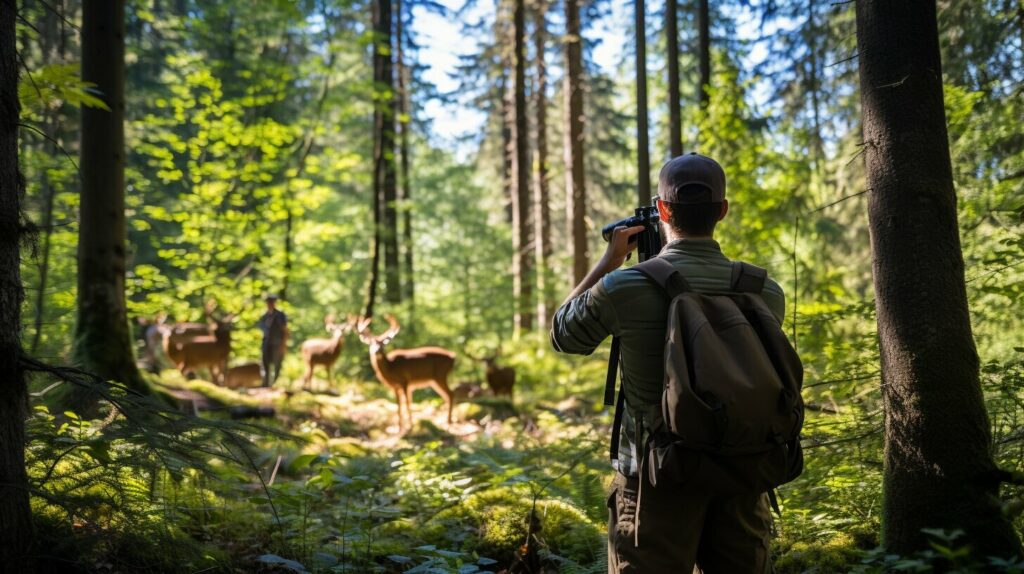
Another way to prevent dangerous animal encounters is by avoiding hiking or camping alone. Travel in groups, and ensure that everyone in your group is aware of the potential dangers and how to deal with them.
By being aware of wildlife behavior, taking precautions, and traveling in groups, you can reduce the likelihood of dangerous animal encounters and stay safe while enjoying the great outdoors.
Researching Animal Activity in Your Area
Before embarking on your outdoor adventure, it is crucial to research the animal activity in the area you plan to visit. This will provide you with valuable information on the type of wildlife you may encounter and how to stay safe around them.
Start by checking with local park authorities or visitor centers for any animal sightings or warnings in the area. They can also provide you with maps showing the locations of recent animal activity.
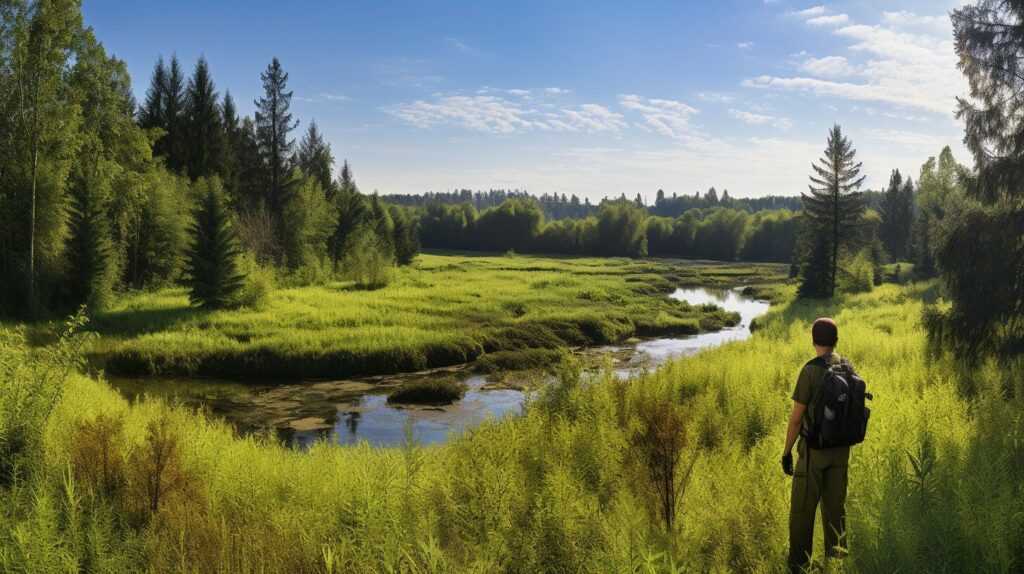
Additionally, you can use online resources to gather more information about the wildlife you may encounter. Websites such as the National Wildlife Federation and the National Park Service offer detailed information on specific species and their habits.
Remember that wildlife encounters can happen anywhere, not just in remote wilderness areas. Be aware of your surroundings and keep an eye out for any signs of animal activity such as tracks, scat, or scratch marks on trees.
By gathering this information and practicing wildlife awareness, you can stay safe and enjoy your outdoor activities without putting yourself in harm’s way.
Using Appropriate Wildlife Deterrents
Encountering a dangerous animal can be a frightening experience. However, there are certain wildlife deterrents that can help keep you safe. By arming yourself with the right tools and knowledge, you can take appropriate precautions to prevent dangerous animal encounters. Here are some animal safety tips for using appropriate wildlife deterrents:

| Wildlife Deterrent | Description |
|---|---|
| Bear spray | This is an effective tool that can deter bears and other dangerous animals in close range. Bear spray is made of capsaicin, a substance that irritates the eyes and respiratory system of the animal, causing them to retreat. |
| Noise-making devices | Noise-making devices like air horns, whistles, and bells can be effective in deterring wildlife. Use these tools to make loud noises when you spot wildlife to scare them away. |
| Ultrasonic devices | Ultrasonic devices emit high-pitched sounds that can be heard by animals but not humans. These devices can be effective in deterring wildlife, but effectiveness may vary by species. |
| Visual deterrents | Visual deterrents like scarecrows, flashing lights, and balloons with frightening faces can be effective in deterring animals. These visual cues can scare off wildlife and prevent dangerous encounters. |
It’s important to remember that no wildlife deterrent is 100% effective. Even with the right tools, it’s crucial to practice wildlife awareness and take necessary precautions to prevent dangerous animal encounters. Always keep your distance from wild animals, and avoid approaching them. If you do encounter a dangerous animal, stay calm and slowly back away from the animal. By using appropriate wildlife deterrents and practicing wildlife awareness, you can minimize the risk of dangerous encounters and stay safe in nature.
Campsite Safety Measures
When camping in areas known for wildlife activity, it is essential to take specific safety measures to minimize the risk of dangerous encounters. Here are some outdoor safety tips for staying safe around wild animals:
| Tip | Description |
|---|---|
| Choose a Safe Spot | When selecting a campsite, choose an area away from animal trails, water sources, and dense vegetation. Keep your distance from any signs of animal activity. |
| Keep a Clean Camp | Keep your campsite clean and free of food scraps and trash. Dispose of all waste in designated containers or by storing it properly. |
| Store Food Properly | Use bear-resistant food containers or hang your food at least ten feet off the ground and four feet away from any trees or other objects. This will prevent wildlife encounters and food theft. |
| Use Proper Lighting | Use bright lights around your campsite to deter animals. Keep a flashlight or headlamp within reach at all times. |
| Be Vigilant | Stay alert and be aware of your surroundings at all times. Listen for any signs of animal activity and keep an eye out for any wildlife encounters. |
By following these outdoor safety tips, you can minimize your risk of wildlife encounters while camping. Remember, staying safe around wild animals is essential to enjoying the great outdoors.

Proper Food Storage
Proper food storage is crucial for animal safety tips and avoiding dangerous animal encounters. When camping or spending time in nature, you must store your food correctly to prevent attracting wildlife to your campsite.
The most important thing to do is to keep your food away from your sleeping area. You should store it in bear-resistant containers or hang it on a tree branch at least ten feet above the ground. Use airtight containers to store your food, and avoid storing food with strong odors such as raw meat, canned goods, and pet food. Instead, opt for dry and freeze-dried foods.
Do not cook, eat, or store food in or around your tent, and avoid wearing strong-smelling perfumes or colognes. After meals, make sure to clean all dishes, utensils, and cooking equipment thoroughly and dispose of any leftover food scraps in designated trash cans or bury them.
Remember that properly storing your food is not only essential for dangerous animal prevention but is also a crucial part of responsible camping and respecting the environment.

By following these food storage tips, you can prevent wildlife encounters and keep yourself and the animals safe. Remember, you are a guest in their home, and it is your responsibility to take precautions and practice responsible outdoor behavior.
Hiking and Trail Safety
While hiking and exploring nature trails is a fantastic way to enjoy the great outdoors, it’s important to be aware of potential encounters with dangerous animals. Follow these outdoor safety tips to stay safe while hiking:
- Stick to established hiking trails and avoid deviating from the path.
- Make noise while hiking, particularly near areas with limited visibility. This will alert any animals that may be nearby and prevent surprising them.
- Travel in groups whenever possible, as animals are less likely to approach larger groups of people.
If you do encounter a wild animal while hiking, it’s essential to stay calm and avoid startling or threatening the animal. Here are additional tips to keep in mind:
- Never approach a wild animal, and always keep a safe distance.
- If you see a bear or mountain lion, slowly back away while facing the animal. Do not run or turn your back on them.
- If an animal charges you, try to make yourself look bigger by raising your arms and standing on your tiptoes. Shout loudly and aggressively, and try to scare the animal away.
By following these outdoor safety tips, you can stay safe while hiking and avoid wildlife encounters. Remember to always be aware of your surroundings and to take necessary precautions when exploring the great outdoors.

Wildlife Watching Etiquette
If you’re an outdoor enthusiast, chances are you enjoy wildlife watching. Observing animals in their natural habitat can be a mesmerizing experience. However, it’s important to remember that you’re a guest in their home, and you should act accordingly to minimize any negative impact on their behavior and environment. Here are some animal safety tips and outdoor safety tips to follow when wildlife watching:
Respect Their Space
When you come across animals in the wild, it’s essential to give them their space. Approaching too closely or making sudden movements can cause them to become agitated, defensive, or even aggressive. Keep a respectful distance, and use binoculars or a spotting scope to admire them from afar.
Stay Quiet and Still
Wild animals are easily spooked by loud noises and sudden movements, so try to keep your voice down and move quietly. Avoid making any sudden movements or gestures that might startle or upset animals. Remember, you’re a guest in their home, and it’s important to minimize your impact on their environment.
Be Mindful of Your Scent
Many animals have a heightened sense of smell, and your scent can alert them to your presence. Try to avoid wearing strong perfumes, colognes, or other scented products that might disturb wildlife. Also, be sure to store any scented items, such as food or toiletries, in airtight containers away from your campsite or hiking trail.
Never Feed Wild Animals
Feeding wild animals can be dangerous for both them and you. Wild animals have specific diets and feeding habits, and feeding them human food can cause digestive problems and lead to dependency on humans for survival. Additionally, feeding wildlife can cause them to lose their natural fear of humans, which can lead to aggressive behavior and dangerous encounters.
Observe From a Distance
Remember, the goal of wildlife watching is to observe animals in their natural habitat, not to interrupt or interfere with their behavior. Keep a respectful distance, and avoid any behavior that might disrupt the animals or their environment. Also, be mindful of any signs that indicate animals are feeling threatened or agitated, and adjust your behavior accordingly.
Take Only Pictures, Leave Only Footprints
Finally, when wildlife watching, always remember to leave the environment as you found it. Don’t leave any trash, food, or other items behind that might disturb the animals or their habitat. Take only pictures and memories, and leave only footprints. This way, you can enjoy wildlife watching while still respecting the animals and their environment.
By following these animal safety tips and outdoor safety tips, you can enjoy wildlife watching while minimizing your impact on the environment and ensuring your safety. Remember, respect for wildlife is key to preserving their natural habitats and ensuring that future generations can enjoy them as well.
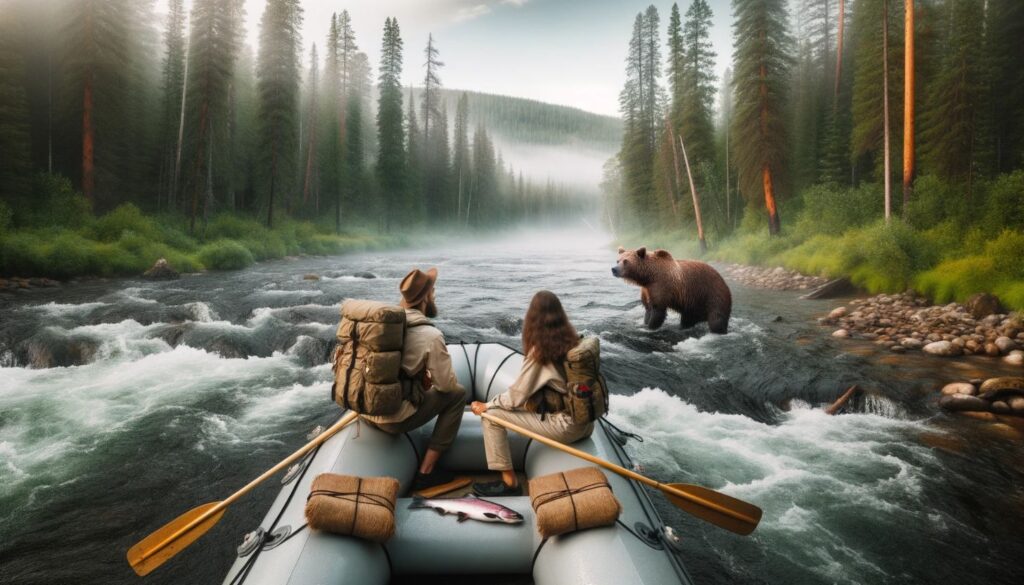
Understanding Animal Signs and Tracks
Being able to recognize animal signs and tracks is an important skill for staying safe around wild animals during outdoor activities. By identifying animal signs and tracks, you can determine if dangerous animals are present in the area and take necessary precautions to avoid wildlife encounters.
When hiking or camping in areas known for wildlife activity, keep an eye out for any signs of animal presence. Look for tracks, droppings, and scratch marks on trees or the ground. These can provide clues about the type of animals that frequent the area.
Bear Tracks
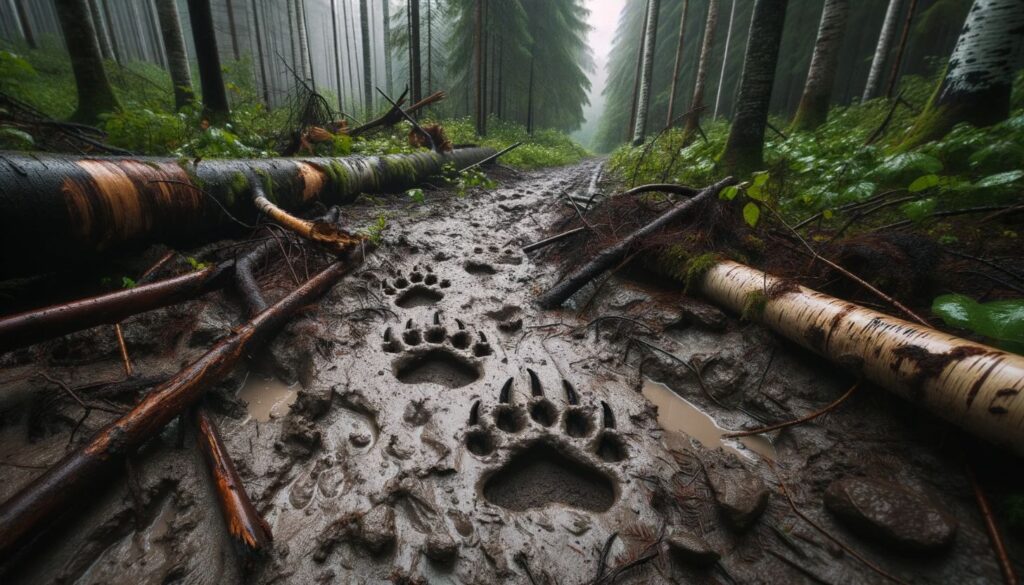
If you come across fresh animal tracks or signs, it is best to avoid the area. Back away slowly without turning your back on the signs, and choose a different route.
Cougar Tracks
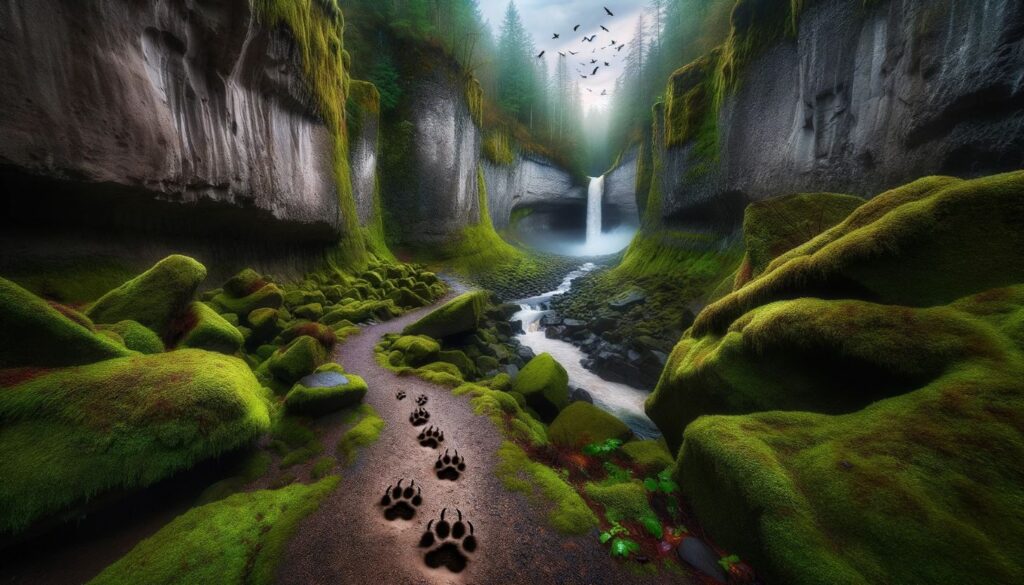
Remember that not all animal signs and tracks are dangerous. Some animals, such as deer and rabbits, are harmless and may even be a pleasant sight to see. However, it is always better to err on the side of caution when it comes to wild animals.
Coyote Tracks

By understanding animal signs and tracks, you can make informed decisions and stay safe while enjoying outdoor activities. Always practice wildlife awareness and take necessary precautions to avoid dangerous animal encounters.
Conclusion
Exploring the great outdoors can be an exciting adventure, but it is crucial to stay safe around wild animals. By following the tips outlined in this guide, you can greatly reduce the risk of dangerous wildlife encounters.
Be sure to educate yourself about animal behavior, research activity in your destination, use proper deterrents, and take necessary precautions. Store food securely, stick to designated trails, and respect wildlife from a distance. Learning to identify animal signs allows you to detect their presence and avoid those areas.
While the wilderness poses some risks, preparation and vigilance will allow you to traverse it safely. With knowledge and caution, you can wander off the beaten path to discover nature’s splendor, all while avoiding its dangers. The call of the wild beckons, so head out prepared and come home with amazing memories, not misadventures.
Stay safe on your outdoor adventures!
FAQ
How can I avoid dangerous animal encounters during outdoor activities?
By following essential animal safety tips and practicing wildlife awareness, you can minimize the risk of dangerous animal encounters during your outdoor adventures. Taking necessary precautions and staying informed about animal activity in your area are key steps in avoiding wildlife encounters.
What should I do if I encounter a dangerous animal?
If you come across a dangerous animal, it is important to remain calm and avoid sudden movements. Back away slowly and try to create distance between yourself and the animal. Do not turn your back or run, as this may trigger a chase response. If necessary, use appropriate wildlife deterrents or seek assistance from a professional.
How can I research animal activity in the area I plan to visit?
To gather information about wildlife encounters and stay safe around wild animals, you can consult local park authorities, wildlife agencies, or online resources. These sources can provide you with valuable information about the types of animals commonly found in the area, their behavior patterns, and any recent sightings or incidents.
What are some effective wildlife deterrents that I can use?
There are several wildlife deterrents available that can help keep dangerous animals at bay. Some popular options include bear spray, noise-making devices, and motion-activated lights. These deterrents can deter animals and provide an additional layer of protection during your outdoor activities.
How can I ensure campsite safety in areas known for wildlife activity?
To minimize the risk of wildlife encounters at your campsite, it is important to properly store your food. Use bear-resistant containers or hang your food from a sturdy tree branch away from your sleeping area. Keep a clean campsite, free of food scraps or scents that may attract animals. Avoid sleeping in clothes that have food odors and follow all designated campsite safety guidelines.
What precautions should I take while hiking or exploring nature trails?
When hiking or exploring nature trails, it is essential to stay alert and be aware of your surroundings. Make noise to alert wildlife of your presence and avoid surprising them. Stay on designated trails, avoid dense vegetation, and carry a whistle or bear bell to alert animals to your presence. It is also advisable to hike in groups and let someone know about your plans before heading out.
How can I watch wildlife responsibly without putting myself at risk?
To observe wildlife from a safe distance without disturbing their natural behavior or risking your own safety, follow wildlife watching etiquette. Use binoculars or a camera with a telephoto lens to get a closer look without approaching the animals. Maintain a safe distance and avoid any actions that may agitate or stress the animals. Respect their space and observe quietly without interfering with their natural habitat.
How can I identify animal signs and tracks to stay safe around wild animals?
Learning to recognize animal signs and tracks can help you determine if there are dangerous animals in the area. Educate yourself about the tracks, scat, scratch marks, and other signs left behind by different wildlife species. Being able to identify these signs will enable you to make informed decisions and take appropriate precautions to stay safe while enjoying nature.




